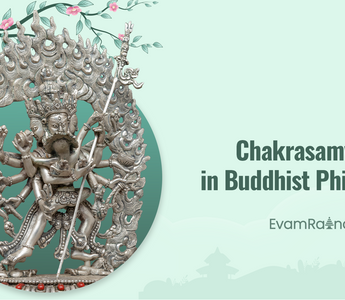The Symbolism and Practice of Chakrasamvara in Buddhism
Chakrasamvara, a pivotal figure in Vajrayana Buddhism, encapsulates profound spiritual teachings and practices. Revered in Tibetan Buddhism, he symbolizes the intricate interplay of wisdom and compassion, guiding practitioners toward enlightenment.
Key Takeaways:
- Chakrasamvara represents the union of wisdom and compassion in Vajrayana Buddhism.
- His complex iconography and symbolism are deeply rooted in esoteric teachings.
- Practices associated with Chakrasamvara are advanced and intended for experienced practitioners.
- Understanding Chakrasamvara involves delving into historical, symbolic, and practical aspects.
Historical Roots and Enduring Appeal of Heruka Chakrasamvara
Chakrasamvara, known as 'The Wheel of Great Bliss,' traces its origins to the early first millennium in India. Its worship subsequently journeyed to Tibet and the Himalayan regions, seamlessly blending with local religious customs. This evolution underscores the enduring allure and adaptability of Chakrasamvara across diverse cultures and epochs.
Beyond Religious Practices
Chakrasamvara's impact transcends religious boundaries, serving as a wellspring for Buddhist artistic expression. Thangkas, sculptures, and mandalas inspired by this deity enrich the tapestry of Vajrayana iconography. Chakrasamvara plays a prominent role in various texts and commentaries in literature, underscoring its theological significance.
Dynamic Depiction
Chakrasamvara is often depicted in a dynamic, simultaneously wrathful and blissful form, united with his consort, Vajravarahi. This portrayal goes beyond mere artistic expression, symbolizing the inseparability of wisdom (prajna) and method (upaya) in the non-dual nature of reality.
Symbolic Richness
Every element in Chakrasamvara's imagery carries profound symbolic meaning. From his implements like the Vajra and bell, symbolizing the union of compassion and wisdom, to his stance, ornaments, and even the number of limbs or heads—each holds esoteric significance, offering layers of interpretation to the initiated.
The Chakrasamvara Tantra
A seminal text in Vajrayana Buddhism, the Chakrasamvara Tantra details the deity's rituals, philosophies, and practices. It is a foundational guide for practitioners, outlining complex rituals and meditative practices leading to spiritual awakening.
Profoundly shaping Vajrayana Buddhism, especially in Tibet, the Chakrasamvara Tantra provides pivotal teachings on the nature of mind, reality, and the path to enlightenment. It has played a crucial role in developing Tibetan Buddhist thought and practice.
Chakrasamvara Depiction in Arts
General Iconography of Chakrasamvara
Chakrasamvara typically appears wrathful yet blissful, symbolizing the transformation of mental afflictions (kleshas) into enlightened wisdom. His blue color signifies the conversion of ignorance into the wisdom of dharmadhatu, the ultimate nature of things.
With four faces of different colors (blue, green, red, and yellow), he represents the purification and transformation of the four poisons (ignorance, jealousy, desire, and pride) into wisdom.
The deity's 12 arms symbolize mastery over the twelve interdependent links of origination, a fundamental Buddhist teaching on the origin of suffering. Each hand holds a symbolic implement, such as a vajra (symbolizing indestructible reality), a drum (representing the primordial sound of reality), and a skull cup (symbolizing the transformation of negative into positive), among others.
Various Forms of Chakrasamvara
-
Two-Armed Chakrasamvara (Sahaja Heruka Chakrasamvara):
Click here to view our 2 Armed Chakrasamvara Thangka Print
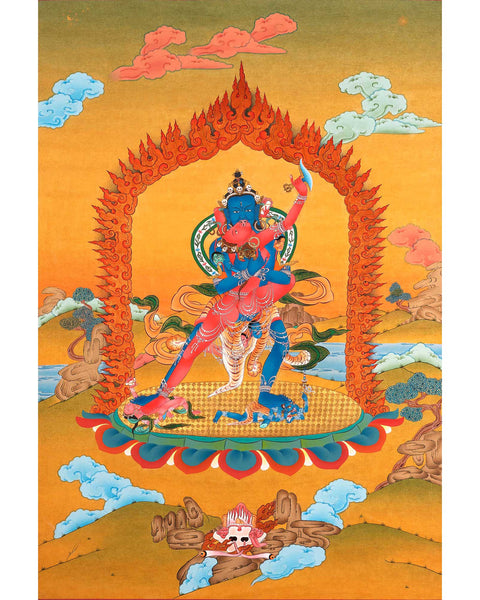
Iconography: This more straightforward form portrays Chakrasamvara with two arms and a single face, often standing or dancing while embracing his consort.
Symbolism: Symbolizing the essence of simplicity and direct realization of the ultimate nature of reality, the two arms represent the union of wisdom and method (or compassion). -
Twelve-Armed Chakrasamvara:
Iconography: The most common depiction features Chakrasamvara with 12 arms and 4 faces.
Symbolism: Multiple arms and faces symbolize the omnipresence and omniscience of Chakrasamvara, embodying complete Buddhahood and integrating all enlightened qualities.
Ritual Items Held by 12 Armed Chakrasamvara
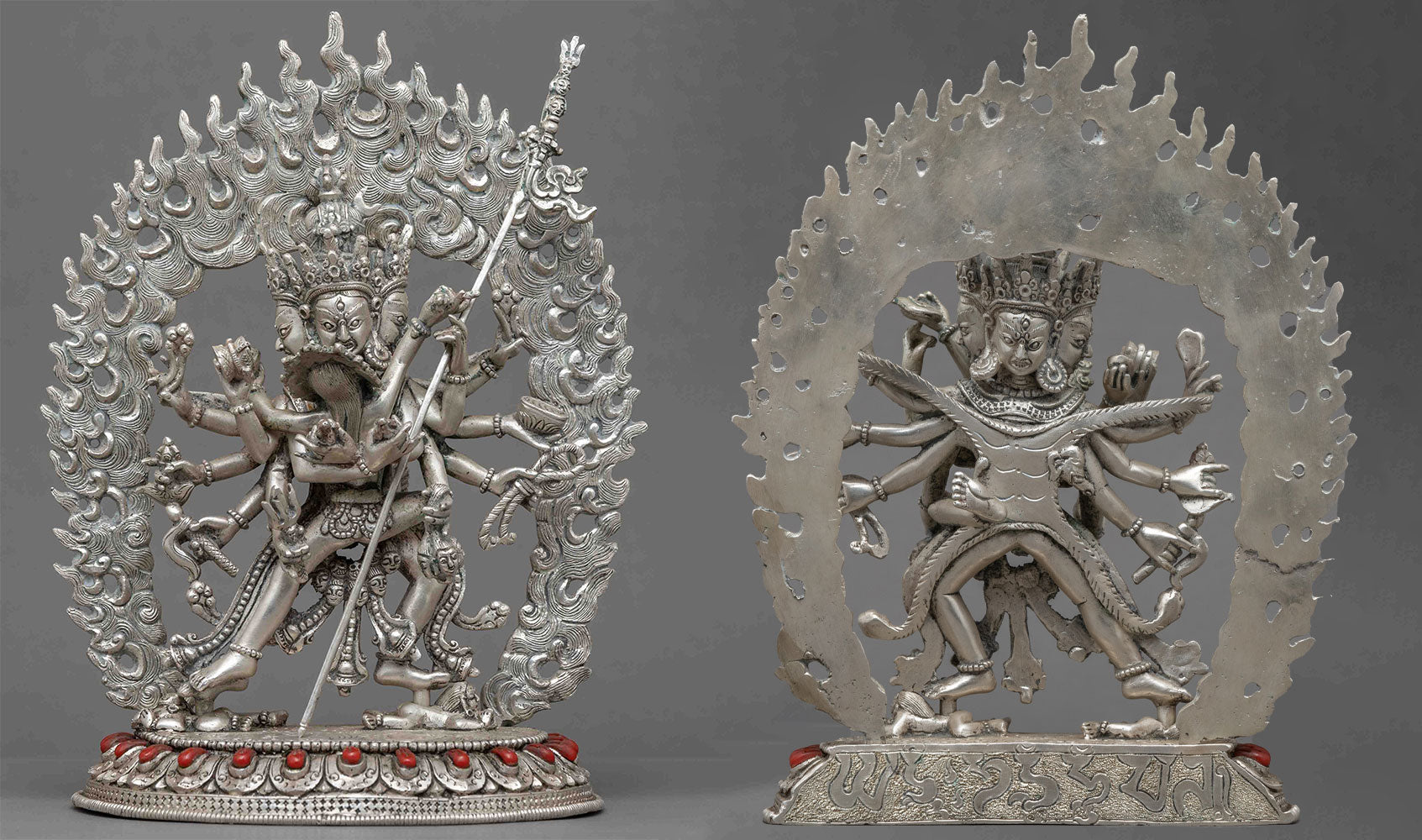
Click here to view our 12 armed Cakrasamvara Silver Statue
The 12-Armed Chakrasamvara is an intricate embodiment, each facet holding symbolic meaning:
Featuring 12 arms and 4 faces, symbolizing the four Buddha families, Chakrasamvara showcases a central serene blue face, with the left face in red, the back face in yellow, and the right face in white.
His hands bear distinctive attributes:
- The first pair holds a Vajra and Bell while embracing Mother Vajravarahi.
- The second pair, outstretched, is adorned with elephant skin.
- The third set wields a Damaru (right) and a Khatanga with Vajra (left).
- The fourth pair wields an axe (right) and a lasso (left).
- The fifth pair brandishes a three-pointed spear (right) and a skull cup (left).
- The sixth set holds a Diggu (right) and Brahma's head (left).
Crowning his topknot is a crescent moon, and in a dynamic dance posture, Chakrasamvara embodies the transmutation of passion into karmic energy adorned with bone and jewel ornaments. Standing atop Mahādeva and Umādevi signifies the transcendence of the ego, while on a multicolored lotus seat, he stands upon a solar disc.
Heruka Chakrasamvara & His Consort Vajravarahi
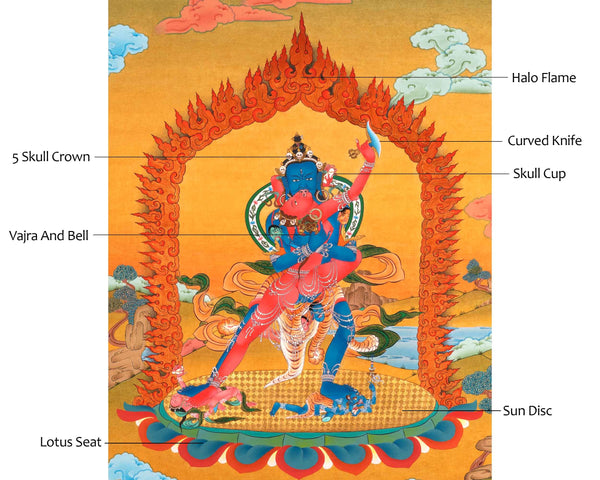
Chakrasamvara, often depicted in union with his consort, Vajravarahi (or Dorje Phagmo in Tibetan), embodies profound symbolism in Vajrayana Buddhism. This union transcends physical representation, serving as a potent symbol of the spiritual path and its ultimate goal.
The iconography of Chakrasamvara and Vajravarahi imparts profound teachings about the nature of reality, the integration of wisdom and compassion, and the transformation of ordinary experiences into the path to enlightenment.
Symbolism of the Union:
Wisdom and Method:
- Chakrasamvara's Role: Represents the 'method' aspect, associated with compassion and skillful means.
- Vajravarahi's Role: Symbolizes 'wisdom,' particularly the understanding of emptiness.
- Significance: Their union underscores the inseparability of wisdom and method, a foundational principle in Mahayana and Vajrayana Buddhism crucial for attaining enlightenment.
Emptiness and Bliss:
- Representation: Chakrasamvara and Vajravarahi embody the union of emptiness (ultimate reality) and bliss (enlightened experience).
- Significance: Highlights that realizing emptiness leads to the supreme bliss of enlightenment and that meditative bliss is rooted in understanding emptiness.
Transformation of Energies:
- Symbolism: Signifies the transformation of ordinary human emotions and physical energies into higher spiritual realizations.
- Clarification: Sexual imagery metaphorically represents the blending and transformation of energies, not an endorsement of ordinary sexual activity.
Non-Dual Nature of Reality:
- Representation: Transcends conventional dualities like subject and object, good and evil, or samsara and nirvana.
- Significance: Illustrates the non-dual nature of reality, where such distinctions are perceived as conceptual and ultimately illusory.
Chakrasamvara Mantra
The mantra of Chakrasamvara, a central deity in Vajrayana Buddhism, is a sacred formula revered for its spiritual potency. The most commonly known Chakrasamvara mantra is:
"OM VAJRA HERUKA SAMAYA MANUPALAYA HERUKA TVENOPATISHTHA DRIDHO ME BHAVA SUTOSHYO ME BHAVA SUPOSHYO ME BHAVA ANURAKTO ME BHAVA SARVA SIDDHIM ME PRAYACCHA SARVA KARMA SU CHAME CHITTAM SHRIYAM KURU HUM HA HA HA HA HO BHAGAVAN SARVA TATHAGATA VAJRA MA ME MUNCHA VAJRI BHAVA MAHA SAMAYA SATTVA AH HUM PHAT"
Benefits of the Mantra:
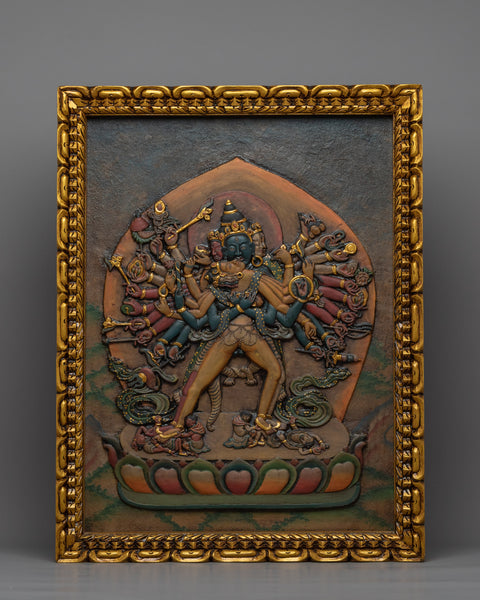
Click here to view our Wooden Relief Chakrasamvara Art
Spiritual Awakening: Regular recitation facilitates awakening one's inherent Buddha nature. It contributes to realizing emptiness, a fundamental aspect of spiritual awakening.
Transformation: The mantra aids in the transformation of negative emotions and behavioral patterns. Consistent recitation transmutes Negative tendencies into positive, enlightened qualities.
Protection: The mantra serves as a source of spiritual protection. Practitioners find support in overcoming internal and external obstacles on their spiritual journey.
Compassion and Wisdom: Regular recitation actively cultivates the qualities of compassion and wisdom. These qualities are crucial elements on the path to enlightenment.
Worldly Benefits: While emphasizing spiritual growth, the mantra is believed to bring about harmony, health, and prosperity in daily life. It is seen as positively impacting spiritual evolution and the practitioner's worldly experiences.
Connection with Chakrasamvara: The mantra strengthens the practitioner's connection with the deity. This deepened connection contributes to a more profound meditation experience and enriches tantric practice.
Chakrasamvara, known as 'Khorlo Demchog' in Tibetan, is central to Vajrayana Buddhism, especially within Tibetan traditions. This deity symbolizes enlightenment and blissful union, often portrayed alongside his consort, Vajravarahi or Dorje Phagmo. The depictions of Chakrasamvara vary, with each form carrying profound spiritual meanings and teachings.


